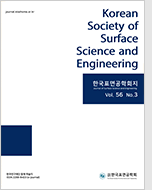
- Past Issues
- e-Submission
-

2021 Impact Factor 1.766
5-Year Impact Factor 1.674
Editorial Office
- +82-2-563-0935
- +82-2-558-2230
- submission@kssse.or.kr
- https://www.kssse.or.kr/

2021 Impact Factor 1.766
5-Year Impact Factor 1.674
The Korean Society of Surface Science and Engineering 2023;56(2):160-168. Published online: May, 2, 2023
DOI : /10.5695/JSSE.2023.56.2.160
Recently, investigation on metallization is a key for a stretchable display. Amorphous metal such as Ni and Zr based amorphous metal compounds are introduced for a suitable material with superelastic property under certain stress condition. However, Ni and Zr based amorphous metals have too high resistivity for a display device’s interconnectors. In addition, these metals are not suitable for display process chemicals. Therefore, we choose an aluminum based amprhous metal Al-Mo as a interconnector of stretchable display. In this paper, Amorphous Forming Composition Range (AFCR) for Al-Mo alloys are calculated by Midema's model, which is between 0.1 and 0.25 molybdenum, as confirmed by X-ray diffraction (XRD). The elongation tests revealed that amorphous Al-20Mo alloy thin films exhibit superior stretchability compared to pure Al thin films, with significantly less increase in resistivity at a 10% strain. This excellent resistance to hillock formation in the Al20Mo alloy is attributed to the recessed diffusion of aluminum atoms in the amorphous phase, rather than in the crystalline phase, as well as stress distribution and relaxation in the aluminum alloy. Furthermore, according to the AES depth profile analysis, the amorphous Al-Mo alloys are completely compatible with existing etching processes. The alloys exhibit fast etch rates, with a reasonable oxide layer thickness of 10 nm, and there is no diffusion of oxides in the matrix. This compatibility with existing etching processes is an important advantage for the industrial production of stretchable displays.
Keywords Aluminum-molybdenum alloy; Miedema's model; Stretchable display: Hillock; metal interconnector.